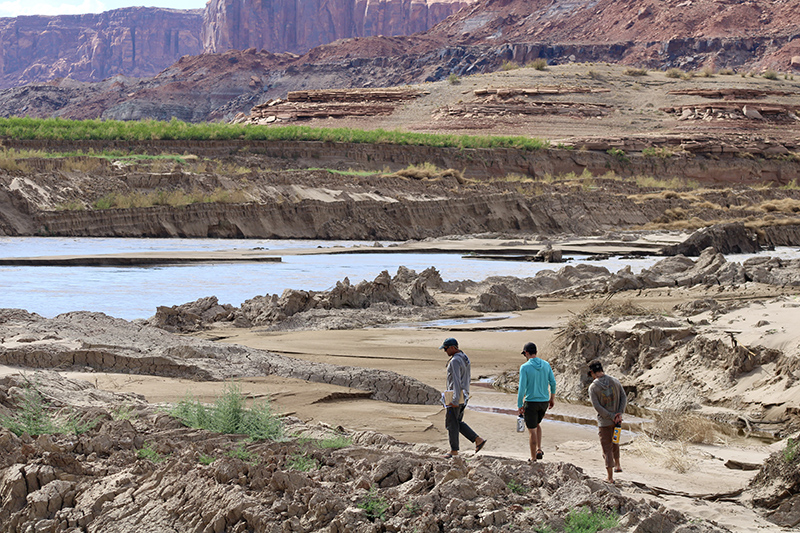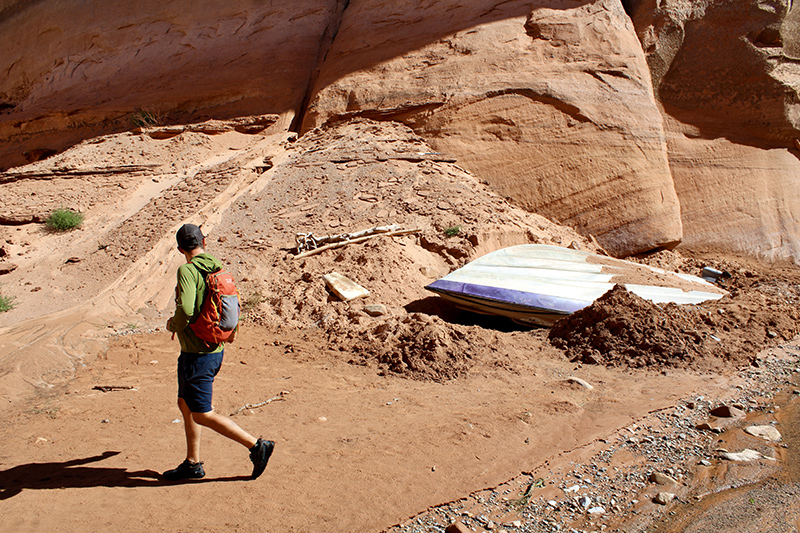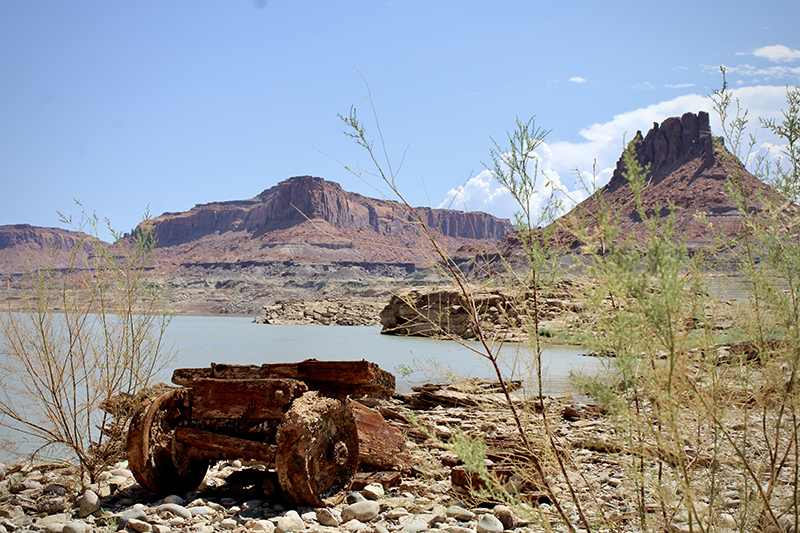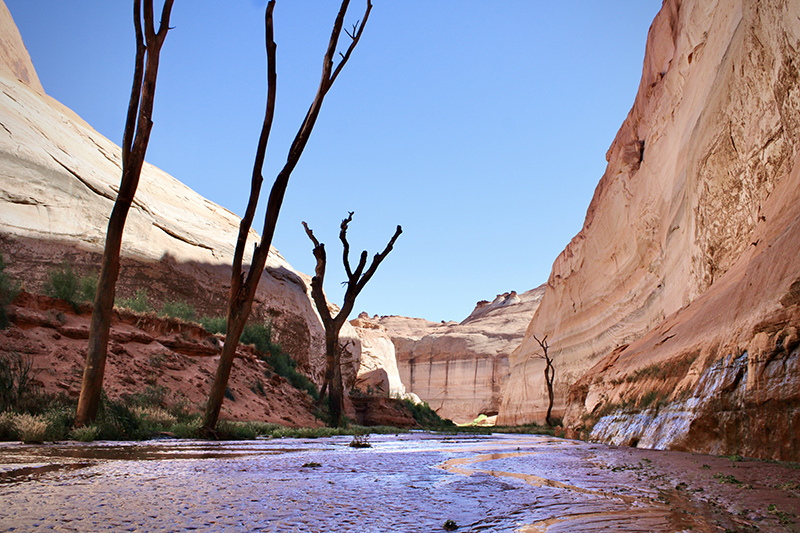On a scorching July afternoon, Mike DeHoff steered his small metal motorboat down what one could argue is the weirdest stretch of the Colorado River in all of its 1,450 miles: the delta of Lake Powell.
DeHoff’s boat floated on roiling water supercharged with sediment, the same color as an iced latte. Craggy, gnarled mud formations rose up from the river channel. Rapids made of mud, which change their contours by the hour, tossed the boat from side to side.
“I mean, look at this,” DeHoff said. “It’s like boating through what you think Mordor would look like.”
Winds whipped up dirt and fine sand from giant, dried-out mud flats, spilling more sediment back into the river. Whole slabs of mud cleaved themselves clean off, like a calving glacier. One attempt to climb up the sediment-caked canyon walls by this reporter and his photographer nearly triggered a dirt avalanche big enough to bury a person. In the delta, the river’s water appeared so thick with sediment that it threatened to turn back into mud at any moment.
The launch point for this trip, an access area called North Wash, near Hite, Utah, is so steep and unstable that rafting outfitters have to use complex winch and pulley systems just to get boats out of the river. It can’t really be called a boat ramp with a straight face, DeHoff said. The chaos created by a receding reservoir caused the Colorado River to jump its channel, and begin carving away at the ramp.
Lake Powell’s delta is the place where the flowing Colorado River meets the stillwater reservoir. And it moves, depending on the year. The river’s flow and the reservoir’s elevation dictate where they meet. It is a “no man’s land,” as DeHoff called it, between the whitewater rapids of Cataract Canyon and the motorboater’s paradise of Lake Powell.
This trip was an investigatory one for DeHoff, a longtime river runner who’s spent decades rafting down Cataract. Features long hidden underwater were on the surface, and he wanted to see them.
For the last five years, with a few partners, DeHoff has run a project called Returning Rapids, an attempt to document the change that comes as the nation’s second-largest reservoir plummets to a record low.

From left, Mike DeHoff, Eric Balken and Pete Lefebvre walk near the mouth of White Canyon, a previously inundated area, now exposed as Lake Powell recedes. (Alex Hager/KUNC)
DeHoff piloted the boat around what he dubbed “mud-bergs,” like icebergs, but made of the claylike mud that collected at the bottom of Lake Powell for decades.
“The mud-bergs that we see defining and changing the river corridor, they change day to day, month to month,” DeHoff said. “And that’s a terra incognita for me.”
When the reservoir was full back in the 1980s and 1990s, this delta would have been deep underwater. With the reservoir at a historic low, more than ever before, that lake bottom is exposed. With the force of gravity behind it, the Colorado River is just doing what it does best: carving canyons.
Though, instead of the grandeur of the Grand Canyon, on this trip DeHoff took us through a mini-canyon of mud at the edge of Lake Powell.
“This is like a river on an acid trip right now,” he said.

Eric Balken, of the Glen Canyon Institute, walks past a sunken speedboat in a side canyon in Glen Canyon National Recreation Area. (Alex Hager/KUNC)
A new historic low
For decades the Colorado River filled Glen Canyon to the brim. Lake Powell has been a fixture of the southwest since the 1960s, providing hydropower to southwestern utilities, water supply reliability to downstream users, and summer vacation memories to families on houseboats.
Over its lifespan, the reservoir’s level has fluctuated wildly, driven by the massive piles of snow that gather in the Rocky Mountains each winter and melt off in the spring.
Since Glen Canyon Dam was commissioned in 1964 and it first began filling, Lake Powell has never been like it is right now, at just 27% of its capacity. It’s threatening to dip below the minimum elevation needed to produce hydropower within the next year. A string of dry winters could push it to dead pool status.
The megadrought plaguing the Colorado River basin has splashed across national and international headlines as the river’s two main reservoirs, Lake Mead and Lake Powell, hit new historic lows. Combined, their dwindling levels leave the water supply for tens of millions in the Southwestern U.S. uncertain. The current crisis garnered attention from the UN’s Environment Program, which warned of water and energy shortages without action.
Prompted by low reservoir levels, the Bureau of Reclamation has called for an unprecedented amount of conservation, two to four million acre-feet over the next year, to preserve current levels at the reservoir. The agency’s leader, Camille Calimlim Touton, threatened the seven states that rely on the Colorado River with unilateral action in absence of a commitment to conserve.
This summer, Lake Powell hit a high point of 3,539 feet in elevation. It is now on a long, slow decline until it receives another rush of snowmelt in spring 2023. As it declines, the reservoir’s upper reaches and its famous side canyons long buried underwater, are reemerging. River runners, scientists, environmentalists and journalists are rushing in to document the rapid change.
Even as problems mount at Lake Powell, DeHoff and others see this moment with a certain kind of somber optimism. They say if the region’s leaders frame it in a certain way, the reservoir’s decline could be viewed as hopeful, not catastrophic.

An ore cart, encrusted in invasive mussel shells, rests on a ledge above a receding Lake Powell. (Alex Hager/KUNC)
Camping on the Colorado
On a beach nestled inside Glen Canyon, DeHoff took a seat in a wooden fold-up chair next to Pete Lefebvre, a longtime river guide. This was camp for the night after boating through mud-bergs, a narrow stretch of sand close to the mouth of Trachyte Canyon, also formerly inundated as part of Lake Powell.
“This is the first time we’ve camped along the Colorado River, where it’s flowing in what would be Glen Canyon proper,” DeHoff said.
The two men work together on Returning Rapids out of their home base in Moab, Utah. The project has started installing time-lapse cameras to watch erosion happen in real-time and get a sense of when mud-buried river rapids will be unearthed.
Early on, Lefebvre said they found that asking one admittedly selfish question — “where can we go rafting?” — led to asking dozens more about sediment movement, water supply, hydropower production and the future of recreation.
“We just didn’t even expect to be studying this area the way that we are right now,” he said of the reservoir delta. “Just because of how fast the river is moving downstream and the lake is dropping.”
The federal government has recently pulled emergency levers to prop up Lake Powell, sending more water from upstream reservoirs and restricting releases from Glen Canyon Dam. With warming temperatures sapping snow in the Rocky Mountains and downstream demands for water going unchecked, Lefebvre said it feels like the whole Colorado River basin is at a breaking point.
“I just think that we don’t, as a species, react until it’s like, ‘Oh man, we need to do something,’” he said. “We’re getting to the point where people are saying, ‘Man, we need to do something.’”
As the region grapples with how to use less Colorado River water, this is the place where those decisions show up on the ground, Lefebvre said.
“Until there’s a scarcity of water, I don’t think people treat it like it is the most important resource we have,” he said. “Being subsidized, being cheap, allows us to act frivolously with it and I think that’s possibly going to change in the future as we get squeezed.”

Dead cottonwoods, long buried under the still waters of Lake Powell, have reemerged as “ghost forests.” (Alex Hager/KUNC)
A side canyon sensory experience
The next day, the boats rolled into Lake Powell and veered up into one of its many side canyons. Years ago, when the reservoir was full, a boat could continue up for miles into this narrow canyon. Now the low level forces boaters off at a narrow sand bar and requires a hike up to see any natural wonders that await.
This canyon featured a forest of formerly underwater cottonwoods, flooded during the reservoir’s initial rise in the late 1960s and preserved in place at its bottom. They now stand darkened and dead among vibrantly green regrowing vegetation. A shallow flowing creek full of tadpoles winds its way through the canyon. Willows line its banks and play host to an insect symphony.
“Oh, man, that smell,” said Eric Balken, as he led a group up the canyon, inhaling deeply. “The willows smell so alive.”
Balken runs the Glen Canyon Institute, which advocates draining Lake Powell and moving what’s left of its waters downstream. DeHoff and Lefebvre’s Returning Rapids is a project underneath the Institute’s umbrella. Balken pointed out a high water mark from the reservoir stained on the redrock one hundred feet or more above our heads.
“There are a lot of big changes coming to the Colorado River,” he said. “And this is one that’s a good change. To see this canyon come back is really special.”
The hike yielded artifacts from when the reservoir still inundated this canyon — four pairs of sunglasses, empty beer cans, a life jacket, a sunken speedboat half-buried in the sand.
Groups like Balken’s want to see Lake Powell’s dam decommissioned and Glen Canyon behind it restored. Balken says this current moment of reckoning on the river, where users are collectively trying to figure out how to use less, should be seen as an opportunity. Lake Powell was built to hedge against lawsuits among the river’s Upper and Lower Basins and ensure a legally-required amount of water flowed downstream. Many of the legal concepts and engineered systems used to manage this river system are woefully out of date, Balken said. A crisis like this one can be a powerful motivator to change, he said.
“Now we’re being given a chance to rethink this place. The reason why it was a mistake was because it had so much value beyond a storage tank,” he said. “We should prioritize water storage elsewhere. We should stop thinking about Glen Canyon as a place to store water and start thinking about it as a place that has natural values, intrinsic values.”
Balken said the federal government and the states who rely on Lake Powell for storage need to be planning for a future without it. Climate change and its ability to warm up and dry out the southwest will continue to put pressure on the reservoir. In the very near future, he said, it might not be feasible to keep Lake Powell in operation for hydropower and recreation. A failure to plan for a very low reservoir, and instead rely on optimistic models that show possible recovery, could put the water supply for downstream users in jeopardy.
“We need to think about what conditions would it actually make sense to fully phase this reservoir out,” he said. “It’s hard for people to imagine right now, but once you can’t come here for your houseboat vacation anymore, once it’s not generating any more hydropower,” it’s easier to begin reconsidering Lake Powell’s usefulness.
Balken noted that his organization’s views were until very recently seen as fringe among the West’s water elite. Now national news outlets have showcased Glen Canyon’s wonders reemerging. He’ll even run into boaters, those who will need to find a new place to dock their houseboat if Balken’s dream is realized, who tell him how fascinating it is to watch the canyon emerge from the water after being buried underneath it.
“It’s encouraging for me,” Balken said. “While also being mindful of the fact that the fabric of western water management is coming apart at the seams.”
This story is part of ongoing coverage of the Colorado River, produced by KUNC and supported by the Walton Family Foundation. This article was also supported by The Water Desk, an independent journalism initiative based at the University of Colorado Boulder’s Center for Environmental Journalism.






